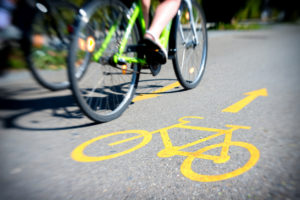Someone asked me recently whether a moped – a motorized bicycle – is forbidden from using Class IV bikeways,

In California, motorized bicycles – mopeds – are not allowed in bike lanes or in protected bike lanes.
also known as protected bike lanes. After doing some research, I believe so. Here’s my interpretation of the law.
Motorized Bicycle – Moped – Laws
In 2001, the United States Congress passed Public Law 107-319. It states that electric bicycles and tricycles that meet the definition of low-speed electric bicycles are regulated by the federal Consumer Product Safety Act.
On the other hand, mopeds and motorcycles are regulated by the Department of Transportation and the National Highway Traffic Safety Administration.
Meanwhile, according to the DMV, unlike riding an e-bike, to ride a moped you must have a motorcycle license or an M2 endorsement. You also need specialty plates and a California ID card.
Moped riders are required to wear eye protection at all times. Like e-bike riders, if the rider is under the age of 18 they must wear a helmet, but that’s where the commonality between e-bikes and mopeds end.
Here’s another difference between laws applying to e-bikes versus mopeds. In 1985, California passed Vehicle Code 21200.5. This law made bicycling under the influence of alcohol or drugs a CUI rather than a DUI. A CUI is a misdemeanor and, if you are convicted, it will show up on your driving record as a conviction. It also carries a $250 fine but no jail time. If the individual is under the age of 21, a CUI conviction can result in the suspension of the person’s driver’s license.
A moped rider who is under the influence is subject to the same drunk driving laws (DUIs), that a motor vehicle driver is. This was decided in 1977 by the California Court of Appeal in People v. Jordan, 75 Cal. App. 3d Supp.1. The court specifically stated that because it [the moped] had a motor, it did not fall under the CUI law.
Mopeds are Not E-bikes
In almost all ways an e-bike is under the same rules and regulations as those that govern bicycles. Yet mopeds seem to be categorized with motorcycles.
Assuming that mopeds are regulated by the same laws as motorcycles, then they are required to follow the same laws as a motorcycle and other motor vehicles. Since neither motorcycles nor motor vehicles are typically permitted to ride in bike lanes, I don’t believe it would be legal for a moped to ride in a Class IV Separated Bikeway either. After all, bikeways are bike lanes that are protected.
For more information about bike laws, visit our bicycle microsite or send us your question and we’ll try to answer it for you.

Hello to whom, it may concern, I Jerry Gatlin, am contacting you to find out if you know of any Specific Laws, regarding Specific Lights, that Gasoline Bicycles must have when one purchase them from Gasoline Bike sellers, like Primo Bike Shop in Los Angeles California. I received a no equipment ticket on August 13Th, 2018 for no Rigistration as well which I found this not to be True.
I just cant seem to find any Specific Laws, for any Specific Lights that are Required on Gasoline Bicycles. Please Help I needs some one that knows of any Specific Laws for Specific Lights for Gasoline Bicycles. 1.8.19…
Hi, Jerry,
Thanks for your inquiry.
A gas bicycle is required in California (I don’t know where your are located), to have at least the same equipment as any other bicycle. There may be additional restrictions or requirements. For instance, in California this applies to a gas bicycle: “Mopeds and high-speed electric bikes are not like regular bikes. Gas-powered bicycles and type 3 electric bicycles (with top assisted speeds of 28 mph) may not be used on trails or bike paths or lanes unless allowed by local authorities. They may be used in bike lanes or separated bikeways adjacent to the roadway. CVC 21207.5 They require helmets and may not be operated by people under age 16.”
A gas bicycle will need, at the very least, to meet the same equipment requirements as any other bicycle. This means: “Lights: At night a white headlight visible from the front must be attached to the bicycle or the bicyclist. CVC 21201(d) and CVC 21201(e)
Reflectors: At night bicycles must have the following reflectors:
Visible from the back: red reflector. You may attach a solid or flashing red rear light in addition to the reflector.
Visible from the front & back: white or yellow reflector on each pedal or on the bicyclist’s shoes or ankles
Visible from the side: 1) white or yellow reflector on the front half of the bicycle and 2) a red or white reflector on each side of the back half of the bike. These reflectors are not required if the bike has reflectorized front and back tires. CVC 21201(d).”
I took this information from CalBike’s California Bicycle Laws page. If you have additional questions, they may be able to help you.
Thanks for stopping by. If you’re interested in bicycle laws and news, please follow us on Facebook.
Be safe –
Jim Pocrass